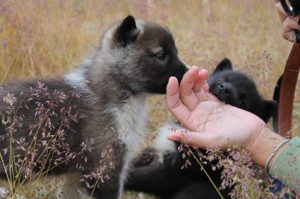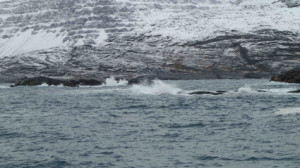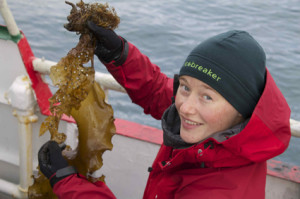The first day of sampling did not go exactly as planned, which is more the rule than the exception when it comes to marine sampling.
Due to bad weather and some technical issues with the boat it was not safe to go as far out to sea as we wanted to, but instead we stayed near the harbor in Qeqertarsuaq and took samples there. With the triangular dredge we got some macroalgae (kelps), including one beautiful species with circular holes in the leaves. This alga is a common species here, but it was new for most of the students attending the course. The roots of the kelp are a habitat for many small animals, which we picked out by hand when we got back to the lab. We also sampled mud with associated fauna, most of which was sieved on deck to wash out the animals. Some of the mud however was taken back to the lab undisturbed to look for meiofauna, small fragile species that would be crushed or lost in the sieving process. In addition to the benthic sampling we took plankton samples with a plankton-net that was dropped down to approximately 25 meters and pulled slowly back to the surface. This turned out to be not very successful probably due to high seas and small manoevering space.
Mette shows the “holey” kelp. Seaweedy and muddy catch.

Samples on deck!
The most abundant animal groups in the benthic samples this day were polychaetes (bristle worms) and amphipods (crustaceans). When we started looking at the samples under the dissection microscope the diversity of polychaete families and species were much higher than expected, and to begin with nearly every new specimen represented a new family. It was, however, very challenging to identify the polychaetes to species for many groups, because the literature and keys that are available usually only include European or Scandinavian species, but with a combination of keying and googling for local Greenlandic fauna we managed to identify a large proportion of the material.
The student group is very varied, with PhD students in fields ranging from neurotoxins and fish physiology to population dynamics and meiofaunal taxonomy. Although everyone has their own little project during the course, we all chip in with the general identification work and compiling species lists of the collected material. Even our fish physiologist, Jeroen, got to identify some polychaetes, and he was fascinated to see that what only looks like small, boring worms to the naked eye are in fact beautiful creatures when you get them under the microscope.

Making friends – there are sledge dogs everywhere!
Written by Mari (University of Bergen) and Inga (Stockholm University)




